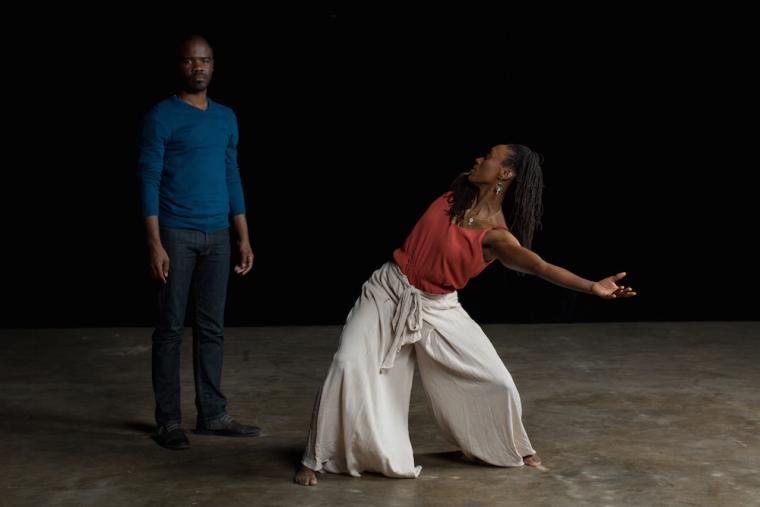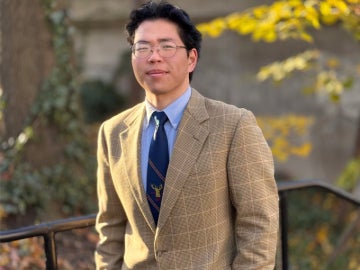Shadows Chasing Light
June 22, 2016
Kasey Cheydleur

Brian Bowers ’08 and Jasmine Powell ’08 collaborated on Shadows Chasing Light, a transmedia experience using poetry, dance, music, and visual art.
Photo credit: Anna Maynard
Brian Bowers and Jasmine Powell, both Class of 2008, met their first year at Oberlin over a meal at Stevenson Dining Hall, and their friendship blossomed from there. Equally creative, they both found a place in the Oberlin arts scene, all while nurturing their diverse interests in the natural and social sciences. Bowers says they were already talking about collaborating together on a number of projects as soon as they left Oberlin.
The idea for their most recent collaboration, Shadows Chasing Light, emerged a year after Bowers self-published a book of poetry by the same name to which Powell contributed charcoal sketches and artwork. They discussed adapting Bowers’ poetry for a show with Powell choreographing and began formally developing the idea around the end of 2014, when the timing seemed right for both.
“As Jasmine was finishing graduate school, I was transitioning into a more dynamic space professionally, and I think the momentum in both of our lives ‘inspired a bit of audacity’ in us that allowed us to consider such an large project,” says Bowers. “In North Carolina, she had an opportunity to propose a new work through Durham Independent Dance Artists as part of their sophomore season, and we said ‘let’s do this’ and chose to codirect and coproduce the show together.”
Part art exhibition and part performance installation, they describe the show as a transmedia experience incorporating work from a combination of artists, video editors, instrumentalists, and designers from around the world to explore “diverse understandings and experiences of love in all its forms.”
The project was a labor of love for the pair, who balanced working on the show in addition to their full-time jobs. They collaborated over phone calls and Skype while Bowers worked full time in Houston and Powell in Durham, North Carolina.
“Coproducing a show with your partner who is more than 1,000 miles away is a challenge and a reward,” Powell says. “We were in constant communication in every way that is available to us. Every aspect of this show has both of our hands involved. I would receive a draft of the music, then I would send my feedback from a choreographer’s standpoint. I would send Brian a video clip of rehearsal, he would Skype his feedback in terms of production and full-scale vision. We would both come to the table with ideas, and then we would work it out to make sure we were staying true to the show and not only feeding our desires.”
The show premiered in Durham in late April. Bowers says it was everything he hoped it would be and more. “Seeing this show come to life was surreal. Just three years ago, we were talking about it as a sort of fantasy. As a first-time codirector and coproducer, and as an author, it really taught us both about the power of audacity—what it means to have a desire manifest or realize something, to birth it against all odds. The audience was so responsive, their energy and awareness was palpable, and I felt many times you could sense the opening of hearts and minds,” he says.
Powell says that moving forward, they would like to make this type of show adaptable for new communities, including Oberlin. She says they would like to avoid performing a “cookie-cutter show” that is the same thing over and over, but rather use the framework of their collaboration for this show to hold collaborative, creative arts workshops that would culminate in a community performance.
Bowers also says he would look forward to bringing the show to Oberlin because the artistic exposure, guidance, and development he received at Oberlin laid a nice foundation to build on as he ventured out into the real world. He adds that as someone “balancing the line between ‘artist’ and ‘professional,’ it would be great to come back to Oberlin and present a workshop on how to use artistic collaboration to promote cross-cultural exchange and creative economy, while encouraging communities to support the local arts where they are and elsewhere.”
You may also like…
Learning by Teaching: Oberlin Students Share Global Music with Young Learners
College and Conservatory students in PACE 103 prepare local children for an immersive community concert at Oberlin.
Nuiko Wadden ’02 Joins Oberlin Conservatory Faculty as Assistant Professor of Harp
The versatile musician brings extensive opera, orchestral, and contemporary music experience to her role
Leo Hidy ’23 Earns 2026 Marshall Scholarship
Leo Hidy ’23, a comparative American studies major who also studied business and economics while at Oberlin, has received a 2026 Marshall Scholarship that will fund two years of graduate study in the UK.


